Yucca leaves turn yellow and dry: why and what to do?
Yucca belongs to the Agave family, although this plant is very similar to a palm tree. This family includes over 45 species, but no more than 7 species are cultivated as indoor ornamental, and a few more can be found in gardens and parks. Yucca is popular with flower growers due to its graceful trunk, the top of which is decorated with a shock of beautiful long emerald leaves.
These evergreens are native to North American countries. At home, yucca is cultivated not only as ornamental plants. Yucca serves as a source of fiber from which clothes, bags, ropes and baskets are made. And from the roots of the culture, local residents have adapted to extract natural red dyes, and parts of the plant are often used by folk healers. Yucca leaves contain starch, so they are often used in cooking.
Content:
- What does a yucca look like
- Basic rules for plant care
- Causes of yellowing and drying of yucca leaves
- What to do, how to save the plant?
What does a yucca look like
Yucca tree trunks, with one or more growth points, can be crowned with drooping or erect narrow long leaves. With the help of competent pruning, the trunks can be given bizarre shapes and the desired branching. Yucca can bloom and bear fruit only in natural conditions, where they are pollinated by special butterflies. The flowering of decorative varieties can be expected extremely rarely and only from hybrids.
With the creation of favorable conditions and tireless care, homemade yucca can bloom only after 6-7 years. This event takes place in the summer. But experienced gardeners have learned to stimulate the budding of mature plants by creating cool conditions in winter. The temperature at this time should not exceed 14 degrees. Yucca flowers are similar to small white bells and gather in panicle inflorescences.
Ornamental plant species do not grow rapidly, but some specimens can reach four meters in height.
All decorative types yucca have common characteristics that distinguish them from other plants:
- the culture grows like a shrub or tree with a powerful trunk
- emerald leaves of a dense and tough texture, usually monochromatic, but sometimes diluted with white veins
- leaves, the length of which reaches a meter, are collected in rosettes
- panicle inflorescences are formed in the middle of leaf rosettes
After flowering, fruits are formed on the plant - these are berries, which eventually turn into seed pods. In indoor floriculture, two types of yucca can most often be found:
- Elephant, which is often called a false palm. It is a shrub plant with long pointed leaves. The elephant yucca gets its name from its trunk, which thickens significantly with age and resembles an elephant's leg. The homeland of this species is arid regions with a small number of pests, therefore the plant is characterized as unpretentious.
- Aloe leaf - with leathery, tough leaves that resemble aloe leaves. Where did its name come from. To grow this species, you need to make some effort. The crown of an adult plant is spherical and crowned with a thick cylindrical trunk.
All types of yucca have a positive attitude to fresh air, so in the warm season, plants are preferably placed outdoors. A place should be chosen with abundant, but diffused sunlight.
Basic rules for plant care
Yucca is notable for its beauty, but in order to preserve the decorative appearance of the plant, you need to properly care for it:
- Lighting. Yucca needs an abundance of light, but direct sunlight has a detrimental effect on plants. Miniature false palms should be placed in western or eastern rooms near windows. If necessary, the duration of daylight hours is increased by artificial lighting.
- Temperature conditions. In the summer season, the temperature of the content of plants should not exceed 25 degrees. If the yucca overheats, then it is placed in a cool place and sprayed, and after a while it is returned to its place. In winter, yucca is comfortable at a temperature of 11-13 degrees.
- Irrigation. Watering decorative palms should be given the size of the plant itself and the pot, as well as the temperature and humidity of the air. In summer, abundant watering is needed. The soil should not dry out more than 2 cm. On average, irrigation is carried out once a week with settled water at room temperature. In the autumn-winter time, watering is reduced.
- Spraying. Spraying is carried out in order to prevent spider mites, but excessive waterlogging can lead to a deterioration in the decorative appearance of the plant. Therefore, this procedure should be carried out carefully and in small quantities.
- Priming. For yucca, a ready-made soil mixture for dracaena and palm is suitable, which contains trace elements necessary for the normal development of plants. Also, the soil can be prepared at home by mixing two parts of sod, leafy earth and sand and one part of humus. Such a composition is optimal for young plants, and for adult specimens, a mixture of sod and leafy soil is suitable, to which sand is mixed in a ratio of 3: 2: 1.
- Top dressing. You need to feed the yucca during intensive growth once a month. Suitable as fertilizers mineral and organic compounds... The solutions are used for spraying the inner sides of the leaves.
- Crown formation. In order for the trunk of the yucca to start branching, it must be cut off. The procedure is applicable for young and healthy plants, no higher than 35 cm. In the second half of spring, two-thirds of the trunk is cut off the yucca. But it is necessary to ensure that leaves or buds remain on the main stem. Sections should be decontaminated to prevent infection. Over time, new shoots will grow from the remaining trunk, and a new plant will grow from the cut top.
Causes of yellowing and drying of yucca leaves
The main problem when growing homemade yucca is the loss of decorativeness. The leaves of the plant may turn yellow and dry, but this is not always a consequence of the disease. If only the lower leaves dry out and die off, then this is a natural process of development. And when there is intense leaf fall, then you should find the cause of the problem and eliminate it.
Miniature palm can lose leaves due to improper care or pest infestation:
- The leaves of the culture turn yellow and dry out due to an excess of light, low humidity or improper watering.
- Due to excessive lighting, dry spots form on the leaf plates, so the plant should be protected from the active sun.
- When waterlogged, the leaves become covered with brown spots.
- If the edges and tips of the leaves dry out, then there is not enough humid air in the room, there are drafts or the palm tree does not have enough watering.
- With hypothermia, the leaves of the flower begin to curl and their edges darken.
- Lack of lighting leads to yellowing of the leaves, and the flower shoots are stretched out.
- The formidable enemies of the false palm are scale insects, spider mites, aphids and thrips.
All these parasites settle on the plant and feed on its juices. Therefore, the leaves begin to turn yellow and dry out.If you do not take any measures, then the flower may die.
What to do, how to save the plant?
The first step is to transplant the affected specimen with a complete replacement of the potting mix. The roots are cleaned from the ground and damaged areas are removed. After that, disinfection is carried out root system manganese solution. After drying the roots, you can plant yucca into new soil. Feeding the false palm should be postponed for a while.
How and how to treat a plant:
- If the plant has suffered from fungal diseases, then you need to remove the damaged areas and carry out the treatment fungicidal preparations... It is not worth watering the plant during treatment. These measures are effective if the disease is at an early stage. In case of extensive infestation, the flower is thrown away, and its pot is treated with high quality.
- When attacked by spider mites, palm leaves are sprayed and washed with tobacco, onion or garlic infusion. The procedures should be carried out systematically until the complete destruction of the pests. If such measures do not give the expected result, then you need to resort to the help of fungicidal preparations. Severely damaged parts of plants must be removed, and with a large number of pests, the culture will need to be transplanted.
- When attacking scale insects, a strong soap solution is used. Each leaf must be properly wiped with a cotton pad soaked in the solution to remove insects. After spraying is carried out with alcoholic tobacco solution or insecticidal preparations are used.
With proper care, yucca can delight its owners for many years. Bribing with its unpretentiousness and decorativeness, mini palm is gaining more and more popularity in indoor floriculture. In addition to decorative qualities, the plant also has a number of useful properties, one of which is air purification in the room.
More information can be found in the video:




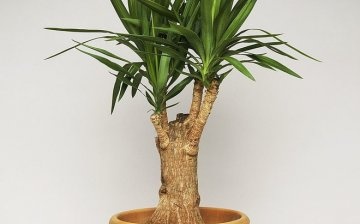
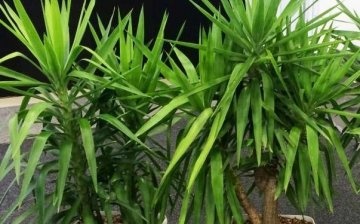
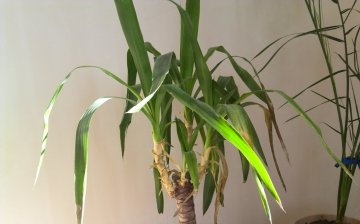
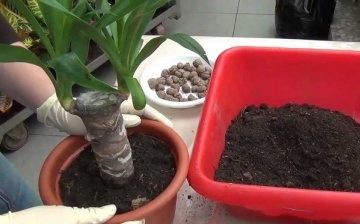





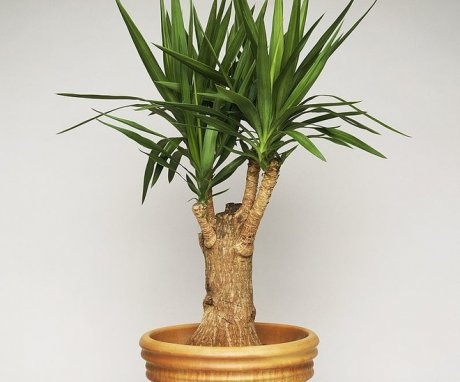
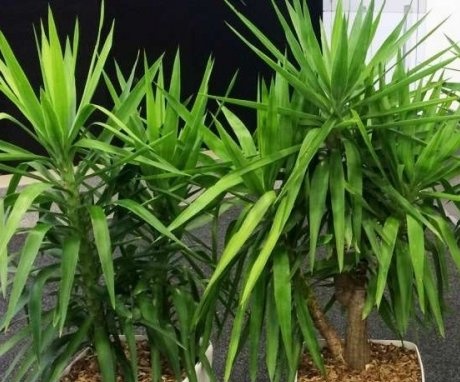
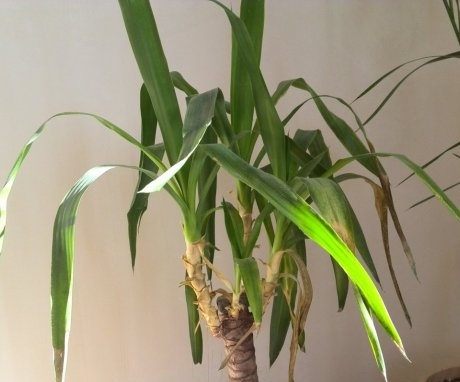

I moved to a new apartment, which is lighter and the windows face south, and faced this problem. The leaves of my plant began to dry out. The situation was saved by spraying and I moved the flower from the window to the floor.
In our plant, the ends of the leaves began to dry and some of the leaves turned yellow and easily separated from the flower. In my opinion, this is from a lack of watering the crown of a flower, because he loves a humid environment, and not a dry one, as in a room. I started regularly spraying the flower with water.